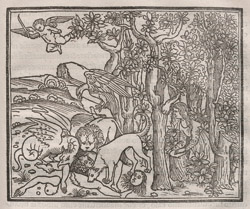 |
|
|
Want to get your hands on an antiquarian treasure? Philip Smith, AB’89, uses digital technology
to reclaim classic texts.
Smith is an editor at Octavo, an Oakland, California, company that produces digital editions and research facsimiles of rare books and manuscripts. In partnership with the Library of Congress, the New York Public Library, the Folger Shakespeare Library, and other archives, Octavo creates Adobe-based CD editions for archivists, educators, students, and bibliophiles. At any moment, Smith says, Octavo is at work on a dozen or so projects; among those “in the hopper” are Galileo’s Compasso Geometrico et Militare, Samuel Johnson’s Dictionary, and a hand-colored edition of Spenser’s The Shepheardes Calender. The electronic editions are designed to give more readers a firsthand experience of a milestone text: each one includes page-by-page views, expert commentaries, and appropriate “marginalia” (a wormholed text, for example, prompts an essay on bookworms). In this way Smith hopes that Octavo will help nonspecialists (undergraduates are a prime marketing target) “bridge the gulf between abstract and concrete thinking” and to understand how a received classic looked and was looked at in its time. Octavo editions, says Smith, whose previous editing jobs include stints with Dover Books and the University of Chicago Press journals division, also emphasize the works’ provenance: “who owned them, how they were cared for, and the like.” Exploring each book’s unique history “teaches us much about the book’s meaning and reception, as well as the often miraculous preservation of cultural materials by caring individuals.” Take, for example, William Blake. The fact that a few collectors safeguarded Blakean volumes through years of literary obscurity is “testimony to the vital importance of individual care in the transmission of culture. In an era in which the individual is often overwhelmed by institutional contexts, standards, and modes of discourse, I think this is a very important message for students to receive.”—M.R.Y.
|
|
phone: 773/702-2163 | fax: 773/702-8836 | uchicago-magazine@uchicago.edu

 Arts
& Letters
Arts
& Letters